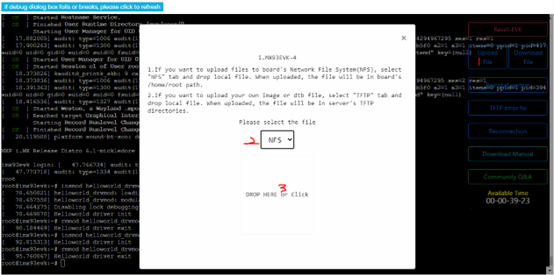
Linux的进程线程通过task struct结构组织起来,每一个进程线程对应一个task struct对象,这些对象通过task list的链表连接在一起。Task struct包含进程线程很多的属性,是kernel的核心结构体,kernel通过current宏来找到进程线程的task struct结构,本实验通过current宏来展示进程线程的进程号、名字、task struct和栈在内存中的地址等基本信息。
1. 在实验本节代码前,准备环境一个ubuntu物理机或者虚拟机,下载并使能交叉编译工具链,然后编译好内核源码,参考《编译内核镜像并在云实验室开发板运行》
2. Linux kernel进程信息的示例代码:
在你要写代码的目录下用touch新建两个文件,一个源码文件,一个Makefile。如下
~/linux_driver/ 06_processinfo$ touch 06_process_info.c
~/linux_driver/06_processinfo $ touch Makefile
~/linux_driver/06_processinfo $ vim 06_process_info.c 将下面的代码复制到06_process_info.c, 如下:
/*
* Copyright 2025 NXP
* SPDX-License-Identifier: GPL-2.0+
*/
1 #include <linux/module.h>
2 #include <linux/types.h>
3 #include <linux/init.h>
4 #include <linux/cdev.h>
5
6 MODULE_LICENSE("GPL");
7 MODULE_AUTHOR("Cloud Lab");
8
9 #define BUF_LEN 0x1000
10 #define VIRTCHARDEV_NAME "virtdev"
11
12 struct virtchardev
13 {
14 dev_t virtdev_id;
15 struct cdev virtdev_cdev;
16 struct class *class;
17 struct device *device;
18 int virtdev_major;
19 int virtdev_minor;
20 struct semaphore sema;
21
22 struct cdev cdev;
23 unsigned char mem[BUF_LEN];
24
25 };
26
27 struct virtchardev *virtdev;
28
29
30 int virtdev_open(struct inode *inode, struct file *filp)
31 {
32 filp->private_data = virtdev;
33
34 down_interruptible(&virtdev->sema);
35 return 0;
36 }
37
38 int virtdev_release(struct inode *inode, struct file *filp)
39 {
40 struct virtchardev *dev = filp->private_data;
41
42 up(&dev->sema);
43 return 0;
44 }
45
46 static ssize_t virtdev_read(struct file *filp, char __user *buf,
47 size_t size, loff_t *ppos)
48 {
49 unsigned long p = *ppos;
50 unsigned int count = size;
51 int ret = 0;
52 struct virtchardev *dev = filp->private_data;
53
54 if (p >= BUF_LEN)
55 {
56 printk("*ppos = %d\n", p);
57 return count ? -ENXIO : 0;
58 }
59
60 if (count > BUF_LEN - p)
61 {
62 count = BUF_LEN - p;
63 }
64 if (copy_to_user(buf, (void*)(dev->mem + p), count))
65 {
66 ret = - EFAULT;
67 }
68 else
69 {
70 *ppos += count;
71 ret = count;
72
73 printk(KERN_INFO "read %d bytes(s) from %d\n", count, p);
74 }
75 printk("Process task struct info::\n"
76 "module : %s\n"
77 "process name : %s\n"
78 "PID : %d\n"
79 "TGID : %d\n"
80 "the task struct address : 0x%pK\n"
81 "the task stack address : 0x%pK\n",
82 VIRTCHARDEV_NAME,
83 current->comm,
84 current->pid,
85 current->tgid,
86 current,
87 current->stack
88 );
89
90 return ret;
91 }
92
93 static ssize_t virtdev_write(struct file *filp, const char __user *buf,
94 size_t size, loff_t *ppos)
95 {
96 unsigned long p = *ppos;
97 unsigned int count = size;
98 int ret = 0;
99 void *kbuf = NULL;
100 struct virtchardev *dev = filp->private_data;
101
102 kbuf = kvmalloc(size, GFP_KERNEL);
103 memset(kbuf, 0, count);
104 if (copy_from_user(kbuf, buf, count) != 0){
105 ret = - EFAULT;
106 }
107 strscpy(dev->mem, kbuf, (count > BUF_LEN ? BUF_LEN : count));
108 ret = count;
109 printk("write bytes: %zu\n", count);
110 printk("Process task struct info::\n"
111 "module : %s\n"
112 "process name : %s\n"
113 "PID : %d\n"
114 "TGID : %d\n"
115 "the task struct address : 0x%pK\n"
116 "the task stack address : 0x%pK\n",
117 VIRTCHARDEV_NAME,
118 current->comm,
119 current->pid,
120 current->tgid,
121 current,
122 current->stack
123 );
124
125 return ret;
126 }
127
128 static const struct file_operations virtdev_fops =
129 {
130 .owner = THIS_MODULE,
131 .read = virtdev_read,
132 .write = virtdev_write,
133 .open = virtdev_open,
134 .release = virtdev_release,
135 };
136
137
138 int virtdev_init(void)
139 {
140 virtdev = kmalloc(sizeof(struct virtchardev), GFP_KERNEL);
141 memset(virtdev, 0, sizeof(struct virtchardev));
142 printk("%s %d\n", __func__, __LINE__);
143 sema_init(&virtdev->sema, 1);
144 alloc_chrdev_region(&virtdev->virtdev_id, 0, 1,
145 VIRTCHARDEV_NAME );
146 virtdev->virtdev_major = MAJOR(virtdev->virtdev_id);
147
148 cdev_init(&virtdev->virtdev_cdev, &virtdev_fops);
149
150 virtdev->virtdev_cdev.owner = THIS_MODULE;
151 virtdev->virtdev_cdev.ops = &virtdev_fops;
152
153 cdev_add(&virtdev->virtdev_cdev, virtdev->virtdev_id, 1);
154
155 printk("%s %d\n", __func__, __LINE__);
156 virtdev->class = class_create(/*THIS_MODULE,*/ VIRTCHARDEV_NAME);
157
158 device_create(virtdev->class, NULL, virtdev->virtdev_id,
159 NULL, VIRTCHARDEV_NAME);
160 printk("Process task struct info :\n"
161 "module : %s\n"
162 "process name : %s\n"
163 "PID : %d\n"
164 "TGID : %d\n"
165 "the task struct address : 0x%pK\n"
166 "the task stack address : 0x%pK\n",
167 VIRTCHARDEV_NAME,
168 current->comm,
169 current->pid,
170 current->tgid,
171 current,
172 current->stack
173 );
174
175 return 0;
176 }
177
178 void virtdev_exit(void)
179 {
180 cdev_del(&virtdev->virtdev_cdev);
181 unregister_chrdev_region(virtdev->virtdev_id, 1);
182
183 device_destroy(virtdev->class, virtdev->virtdev_id);
184 class_destroy(virtdev->class);
185
186 kfree(virtdev);
187
188 }
189
190 module_init(virtdev_init);
191 module_exit(virtdev_exit);
编写Makefile:
PWD := $(shell pwd)
KERDIR := /home/test/kernel_build/linux-imx
obj-m += 06_process_info.o
all:
make -C $(KERDIR) M=$(PWD) modules
clean:
make -C $(KERDIR) M=$(PWD) clean
3. 编译:
~/linux_driver/06_processinfo$ export CROSS_COMPILE=~/toolchain/arm-gnu-toolchain-13.3.rel1-x86_64-aarch64-none-linux-gnu/bin/aarch64-none-linux-gnu-
~/linux_driver/06_processinfo$ export ARCH=arm64
~/linux_driver/06_processinfo$ make
编译完成后当前目录会有如下文件
~/linux_driver/06_processinfo$ ls
06_process_info.ko
4. 替换云实验室开发板镜像并重新启动
根据《编译内核镜像并在云实验室开发板运行》替换dtb和image,这里仍然需要这一步,因为内核模块在加载时需要和内核编译版本相匹配
上传并替换云实验室板子的dtb和Image,依次点击用户网页端下面1,2,3的位置,在点击位置2时,选择TFTP,点击3后选择文件~/kernel_build/linux-imx/arch/arm64/boot/dts/freescale/imx8mp-evk.dtb和~/kernel_build/linux-imx/arch/arm64/boot/Image

上传成功后,点击下方PowerReset EVK按钮,重启开发板。

至此,开发板开始运行自己修改编译的linux镜像。
5. 上传自己编译的字符驱动模块
在4中编译出了关于mutex应用的内核驱动程序06_process_info.ko,通过一次点击下图中的1,2,3位置,然后切换到本地对应的文件目录上传。

6. 运行字符驱动模块
在执行下面的操作前要先使能串口终端的log打印,否则会看不到串口终端打印信息:
root@imx93evk:~# echo 8 > /proc/sys/kernel/printk
执行insmod加载模块,可以看到log里打印出了进程名字insmod,PID等信息。

当向内核模块写入字符串,可以看到sh进程在工作,并打印了相关信息

然后读取刚才写入的信息时,可以看到cat进程的相关信息,log如下:
